It's easy to fall short on this mineral. Avoid trouble by getting more of these ample food sources of iron in your diet.
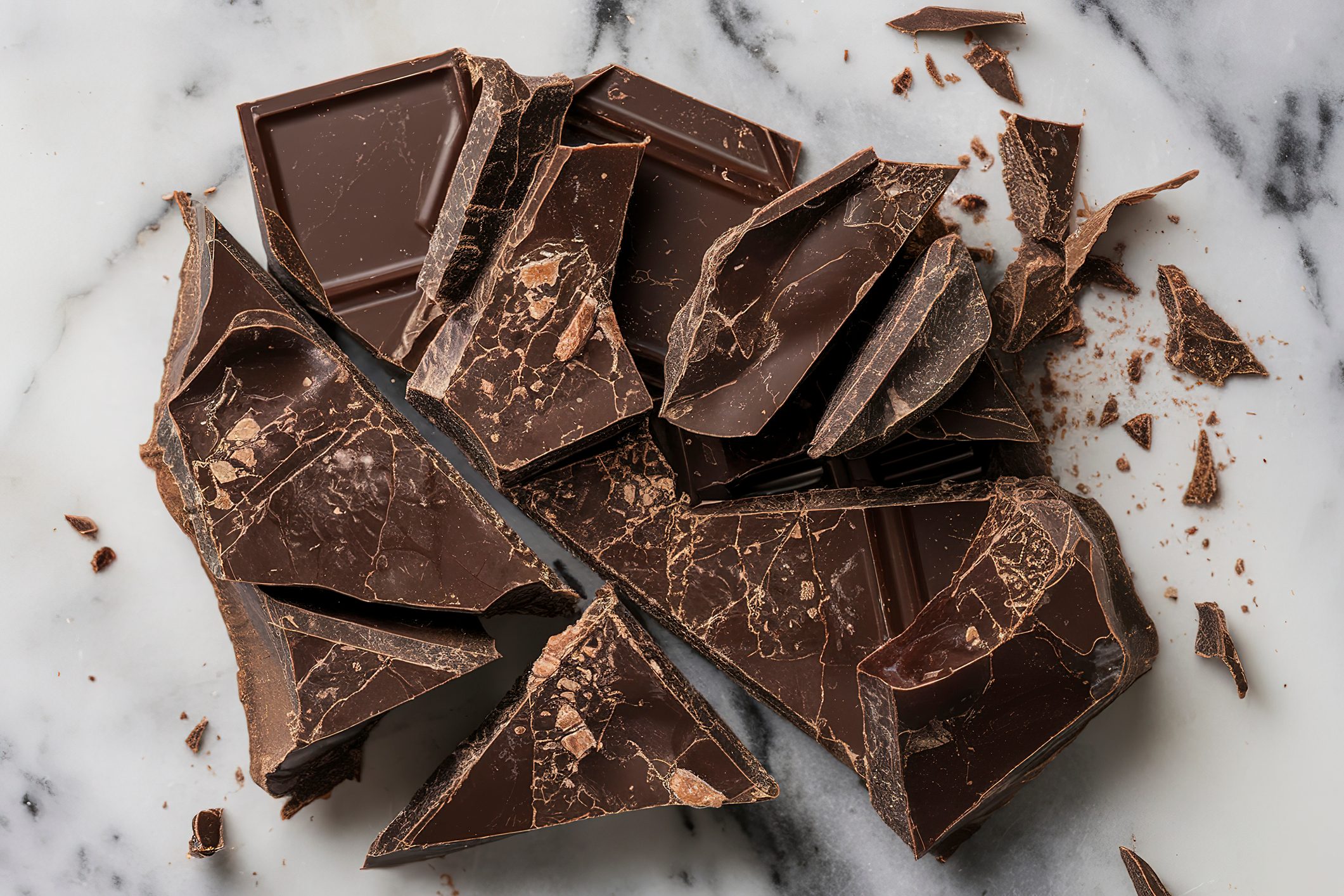
The 9 Best Sources of Iron, from Leading Clinical Experts

About the experts
|
Highlights
|
Nearly one in three Americans may need to add more foods containing high levels of iron into their diet, according to 2024 research published in JAMA Network Open.
The researchers warn that low iron may be a “widespread, under-recognized public health problem” in the United States, finding that at least 14% of adults have absolute iron deficiency. Meanwhile, another 15% of U.S. adults have a “functional iron deficiency,” meaning their body isn’t absorbing or using iron efficiently enough. However, the research suggests that many cases go undiagnosed.
Women under 50 are most at risk for low iron levels. The research found that more than half of women between ages 18 and 50 have some form of iron deficiency, likely due to menstruation and the increased iron demands that come with pregnancy. According to the American Society of Hematology, other groups at risk include:
- Children
- Vegetarians or vegans
- People with gastrointestinal disorders
Another study, published in 2023 in Nutrition, adds that approximately 20% of athletes are iron deficient—especially female athletes.
In fact, iron deficiency is the most common nutritional disorder worldwide, per 2023 research published in the European Journal of Medical Research—and it’s associated with a range of chronic diseases.
That’s because iron plays so many essential roles in the body, explains Julia Zumpano, RD, LD, a registered dietitian with the Cleveland Clinic Center for Human Nutrition. Iron is responsible for getting enough oxygen to the cells and tissues in your body—and your body uses this oxygen for its energy. “Iron helps get your brain cells enough oxygen to function as well,” she says. “It also aids in a healthy immune system and healthy hair growth.”

Why iron matters for your health
“What doesn’t iron do?” says Lindsay Malone, MS, RD, LD, an instructor and clinical dietitian in the Department of Nutrition at Case Western Reserve University School of Medicine.
“Iron is essential for overall health because it carries oxygen to tissues, supports energy production, boosts immune function, and (my favorite) promotes hair growth,” she says. Iron plays a role in brain development and function as well by aiding in the synthesis of neurotransmitter, such as serotonin. “It is also a cofactor for several enzymes involved in DNA synthesis and detoxification.”
In foods, iron comes in two forms. “Heme iron comes from animal sources, and non-heme iron comes from plant sources,” Zumpano explains.
According to 2024 research from StatPearls, heme iron is absorbed in our bodies more efficiently than non-heme iron. It says that about 25% of dietary heme iron gets absorbed, while less than 17% of plant-based iron gets absorbed (sometimes, with a bioavailability as low as 5%). When it comes to this plant-based iron, “You need vitamin C with non-heme iron sources to increase absorption,” Zumpano explains.
Iron deficiency is a major contributor to anemia, or not having enough healthy red blood cells to carry oxygen around your body. Sandra Zhang, MS, RDN, LDN, a registered dietitian nutritionist and pediatric dietitian at the Frances Stern Nutrition Center at Tufts Medical Center, says that symptoms of iron deficiency anemia include:
- Fatigue and weakness
- Lightheadedness
- Headache
- Cold hands and feet
- Pale skin
- Shortness of breath
- Fast heartbeat or heart palpitations
But people can be deficient in iron and not yet anemic, she says. Research published in Australian Prescriber in 2021 says that non-anemic iron deficiency can result in a wide range of symptoms, which may seem unexplained or non-specific. But it’s associated with issues including:
- Weakness, fatigue, and reduced exercise performance
- Difficulty concentrating and brain fog
- Poor work productivity
- Mood changes, like irritability or anxiety
Hair loss, nail changes, poor sleep, and weakened immune function can also occur with iron deficiency.

Why is iron deficiency common?
There are a few main reasons why iron deficiency is so common, Malone explains. “They basically fall into a few categories: insufficient intake, high demand, and poor absorption.”
Insufficient intake
“Most food sources in iron come from animals, which are costly to purchase and labor intensive to raise on your own,” Malone says. “Globally, this is certainly an issue.”
Plants can provide some iron, but it’s not as bioavailable and requires good stomach acidity and the presence of vitamin C for absorption. “Volume-wise, you’d have to eat a lot more plant sources than animal sources to get what you need.”
High demand
Women are at a higher risk for iron deficiency because females have transient needs depending on their lifecycle, Malone says. For example, during pregnancy, iron needs go up because of increased blood volume and fetal development. “It can be challenging to eat enough iron-rich foods because of taste preferences and space for food.”
Gastrointestinal issues, menstruation, and growth also lead to higher iron demands.
Poor absorption
“Iron is absorbed through the small intestine,” Malone explains. “For many people with gut dysfunction, iron absorption can be impaired.” Other nutrients can compete with or reduce iron absorption, too—as can taking some medications.
“Iron absorption is also influenced by other factors like stomach acidity and vitamin C content (for non-heme iron),” she says.

The best foods containing high levels of iron
Iron is an essential nutrient, meaning we need to get it through our diet. Fortunately, there are many different types of food that contain iron, and Zumpano suggests starting with small, strategic steps.
Aim to include an iron-rich food from the list below with each meal, she says. “Pair plant sources [of iron] with food sources of vitamin C to increase absorption, such as citrus fruits, strawberries, red peppers, broccoli, or tomatoes.”
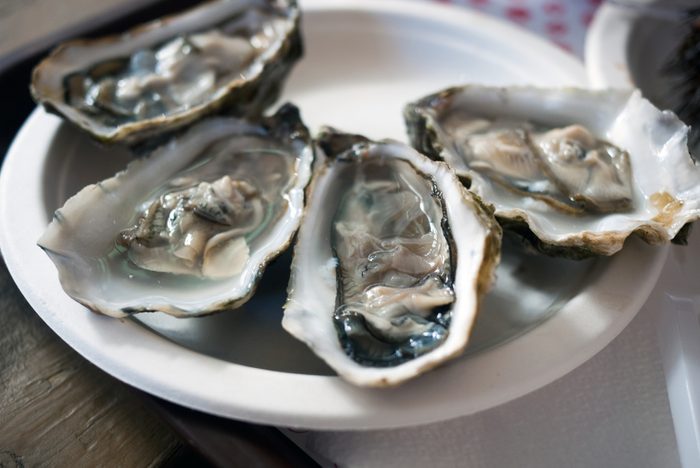
1. Shellfish
“Oysters—these guys are packed in nutrients,” Zumpano says. “They are one of the best sources of heme iron [and] they contain copper, which helps the absorption of iron.” They can be eaten raw or cooked, but cooking them helps prevent the risk of bacterial contamination, she explains.
Mussels have high iron levels as well, Zhang says. “Other small seafood like crabs, clams, sardines, and shrimp also have considerable amounts of iron,” she adds. “These foods also are good sources of protein, omega-3 fatty acids, and zinc.” She recommends including them in your diet twice a week.
According to the USDA:
- Oysters (3 ounces) contain 7.83 milligrams (mg) of iron
- Blue mussels (3 ounces) contain 5.7 mg of iron
- Queen crab (3 ounces) contains 2.45 mg of iron
- Clams (3 ounces) contain 2.39 mg of iron
Sardines aren’t shellfish, but with 4.35 mg of iron per cup of canned sardines, they’re certainly an honorable mention. While we’re in the seafood department, canned tuna also contains about 1 mg of iron.

2. Red meat
Red meat has some of the highest levels of iron because, like us, animals store iron in their muscles, Zhang explains. (The same is true for organ meats, which we’ll get into below.) “Depending on individual caloric needs, fatty or lean red meat can be incorporated more often, two to three times per week, to offer more iron and protein,” she says.
Malone says that red meats like beef, lamb, and bison are also high in another vitamin many Americans fall short on: vitamin B12. “Choose grass-fed, organic when possible for higher amounts of omega-3 fats and phytonutrients,” she says. “Cook low and slow to improve [red meat’s] digestibility.” Think braising, slow cooker—or for a faster method that still breaks protein down well, use a pressure cooker. To round out a nutritious meal, add cooked red meat to burrito bowls, burger bowls, or soup packed with vegetables and whole grains.
You can expect a good helping of iron from several red meat sources:
- Depending on the type of beef, a 3-ounce portion ranges from about 2 mg (for rib eye cuts) to almost 5 mg (for an outside skirt cut)
- A ground beef burger patty contains around 2 mg of iron
- 3 ounces of lamb tenderloin or shoulder has about 2 mg of iron
- 3-ounces of ground, grass-fed bison has 2.7 mg of iron

3. Organ meat
“In the old days, [beef liver] was a staple meal,” Zumpano says. “It’s making a comeback.” She says beef liver is often pan-fried with onions for extra flavor or minced or chopped and added to ground beef to make a bolognese or tacos.
“Beef liver is an excellent source of Vitamin A, which is crucial for vision, healthy skin, and a robust immune system,” Zumpano says. “It’s packed in B vitamins, which support neurological health and energy production.” It’s also a good source of copper, zinc, and selenium—powerful antioxidants that protect cells from damage—and choline, which supports brain and eye health.
Other types of organ meat, such as blood, marrow, or heart, are enjoyed in some cultures, Zhang adds. “But organ meats like the liver also tend to have high levels of vitamin A, which can be toxic at high levels of intake,” she explains. That’s why she recommends limiting organ meat to once or twice per week in moderate amounts.
Here’s how much high-quality, heme iron you can get from organ meats:
- Beef liver (3 ounces) has 6.09 mg of iron
- Chicken liver (one liver) has 5.67 mg of iron
- Lamb kidney (3 ounces) has 12.50 mg of iron
- Roasted bone marrow (100 grams) has 1.2 mg of iron
- Blood sausage has 6.4 mg of iron in four slices

4. Legumes and seeds
Beans (a type of legume) are generally a good source of iron, but Zumpano says that one variety stands out in particular: canned white beans. Beans contain non-heme iron, so remember to pair them with vitamin C. Zumpano recommends a white bean salad with red peppers, spinach, and broccoli with a lemon olive oil vinaigrette.
“Beans also provide B6, fiber—which helps manage blood sugars, cholesterol, and digestion—and protein, which helps build muscle mass and maintains tissues and bones,” she says. “They are also a great source of potassium, which aids in muscle and nerve function and healthy blood pressure values.”
Other legumes and nuts are good sources of iron, too, Zhang says—as are seeds. “They also provide fiber and vitamins,” like folate and magnesium. As these are lean sources of protein, she says they can be included in an everyday diet.
Another addition: “Lentils are high in non-heme iron,” Malone says. “Add them to soups, stews, salads, or make lentil patties,” she suggests, ensuring there’s a source of vitamin C, like tomato sauce or spinach, to boost iron absorption. Soaking, sprouting, and using a pressure cooker to make lentils and beans can also reduce compounds that inhibit iron absorption, Malone explains.
Some top legumes and seeds for iron content include:
- One cup of white beans contains 6.62 mg of iron
- One cup of lentils contains 6.59 mg of iron
- One cup of kidney beans or chickpeas contains 4 or 5 mg of iron
- One cup of pumpkin seeds has about 2 mg of iron
- One cup of roasted cashews has around 8 mg of iron
- One ounce of chia seeds has 2 mg of iron
Many other types of nuts and seeds have between 1 to 2 mg of iron per serving, too, per the USDA Nutritional Database.

5. Soy products
Soybeans are one type of legume with high levels of iron (roasted soybeans have almost 7 mg per cup), and so soy products also pack a punch.
Soy-based foods like tofu and tempeh are great sources of plant-based protein—and with no cholesterol and little fat. What’s more, most of the fat in tempeh and tofu is healthy unsaturated fat like omega-3, which helps lower your cholesterol levels and reduces your risk of heart disease, according to the Cleveland Clinic.
Each also contains a ton of nutrients, including manganese, copper, B vitamins, fiber, and of course, iron. Both tempeh and tofu contain around 2 mg of iron per 3-ounce serving.
Soy milk is often fortified to include iron, too. The amount varies based on the brand, but most contain around 1.1 to 1.5 mg of iron per cup.
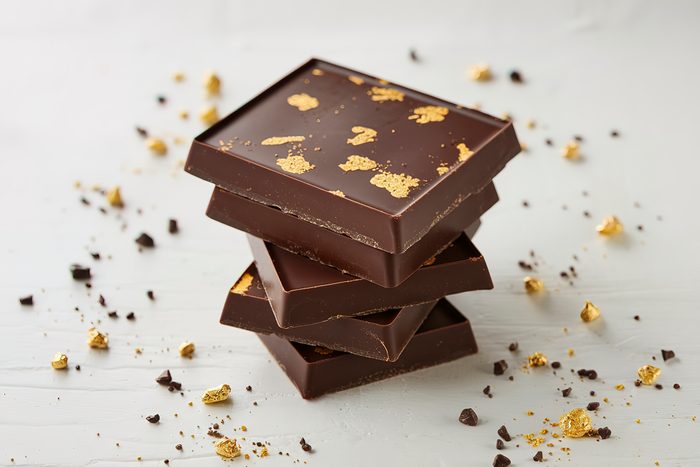
6. Dark chocolate
Another bean that’s especially rich in iron? Cacao. And the fermentation process that cacao beans undergo before being made into chocolate actually enhances the bioavailability of its plant-based iron, according to 2022 research published in the Journal of Food Composition and Analysis.
But there’s a catch: the higher the cacao content in the chocolate bar, the more iron you’re getting. Per the USDA, a one-ounce serving of a dark chocolate bar with 70 to 85% cacao has around 3.4 mg of iron. That’s about three thin squares broken off a bar.
Even though its processing improves the plant-based iron’s availability, eating dark chocolate with vitamin C will still help you absorb it better. Pair dark chocolate with strawberries or an orange (and add some nuts for even more iron!). Keep in mind that orange or other fruit-flavored chocolate doesn’t actually contain vitamin C—these items usually use oils or extracts to produce the flavor.

7. Poultry
Poultry products aren’t super rich in iron, but their animal-based heme iron is better absorbed by the body than plant sources with higher content. Plus, poultry tends to be a more affordable protein source than red meat—and it contains two to five times less saturated fat than red meat, on average.
A diet high in saturated fat from red meat is associated with a greater risk of heart disease, cancer, and dementia—while white meat has either neutral effects or is associated with a lower risk, according to 2022 research published in Foods. (However, processed white meat, like turkey deli slices, is considered a heart disease risk factor.)
According to the USDA:
- Turkey thigh, back, or other dark meat contains around 1.2 mg of iron per 3-ounce serving
- Roasted duck has 3.78 mg of iron in a 1-cup serving
- Canned chicken has 2.24 mg of iron per 3-ounce serving
- Chicken thigh or drumstick contains about 1.3 mg of iron for a 3-ounce serving
- One large egg contains about 0.9 mg of iron (most of this content is in the yolk)
- A 3-ounce chicken breast has roughly 0.9 mg of iron
A word of wisdom from the Cleveland Clinic: for all poultry cuts, remove the skin before cooking to reduce your saturated fat intake (without taking away from its iron content).
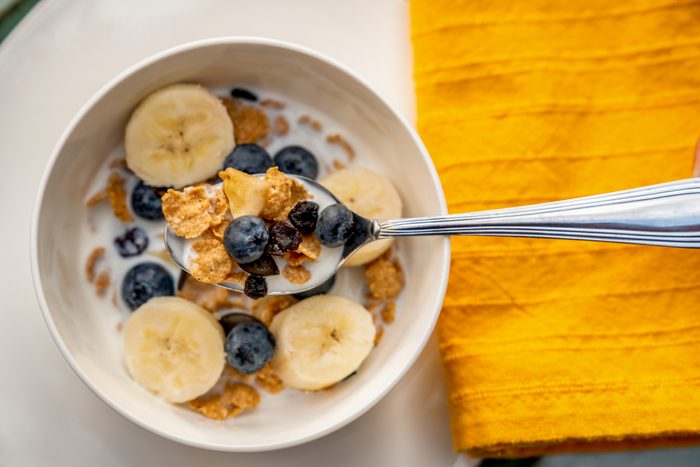
8. Iron-fortified products
Adding fortified foods to your diet, like fortified cereal for breakfast, is an easy way to start getting more iron right away, Zumpano suggests. In fact, the 2024 StatPearls research says that fortified foods like bread, cereal, and nutritional drinks represent about half of dietary intake in the U.S.
A 2022 review article published in Critical Reviews in Food Sciences and Nutrition says that consuming foods fortified with iron is a safe, effective strategy for getting enough iron. However, keep in mind that iron-fortified foods contain non-heme iron—and the review says that some people may experience side effects, such as stomach upset, from eating fortified foods.
Fortified foods can vary widely in their iron content depending on the brand and formulation, but the USDA offers a few examples:
- Enriched all-purpose wheat flour can contain around 5.8 mg per cup
- Fortified oats can contain 6.92 mg of iron per serving
- Two tablespoons of fortified peanut butter can contain 5.6 mg of iron
- Fortified breakfast cereals can contain up to 18 mg per serving—a full daily value or more for most people
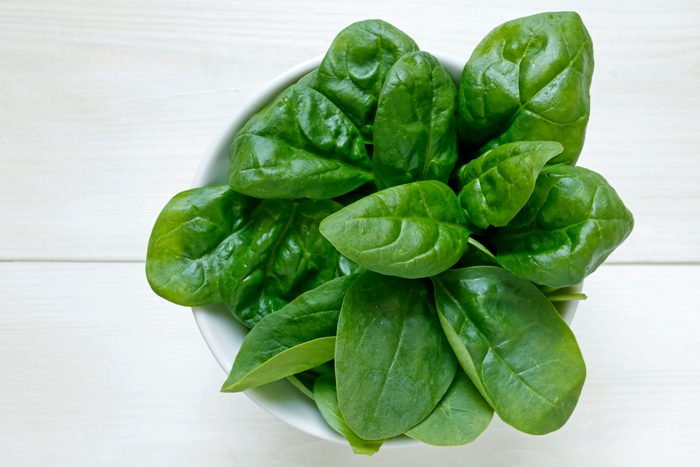
9. Dark leafy greens
Leafy greens aren’t the greatest source of iron—but some types do contain a decent amount, and there are plenty of other reasons to get more greens in your diet.
A 2024 review of research published in Food Production, Processing and Nutrition says that leafy greens are loaded with plant-based nutrients thought to reduce the risk of age-related diseases and chronic health issues. Specifically, the review points to studies that have shown leafy greens have antidiabetic effects, antibacterial properties, wound-healing capacities, and neuroprotective effects (they may even improve your memory).
When it comes to iron content, spinach comes in with the most, Zhang says. Though greens like Swiss chard pack a punch, too.
Here’s what the USDA has to say:
- One cup of boiled spinach has 6.4 mg of iron
- A serving of raw spinach (about 30 grams or one loosely-packed cup) has 0.81 mg of iron
- One cup of cooked Swiss chard contains 3.95 mg of iron
- One cup of cooked kale has 2.5 mg of iron
- One cup of chopped raw kale has 2 mg of iron

Iron absorption tips you should know
Remember: vitamin C enhances the absorption of non-heme iron, so make sure you eat plant-based sources of iron with foods like kiwis, green peppers, citrus fruits, tomatoes, broccoli, greens, tropical fruits, or other foods high in vitamin C.
But no matter what type of foods containing high levels of iron you enjoy, our experts offer a few additional tips to ensure your body’s making the most of this essential mineral.
Look out for nutrient interactions
“Calcium lowers the absorption of iron, so having iron foods and supplements away from calcium-rich foods is recommended,” Zhang says. This is because calcium competes with iron for absorption in the small intestine and can block or reduce the effectiveness of compounds in the body that transport iron.
Dairy foods are high in calcium, but some iron-rich foods also contain calcium. That doesn’t mean you should avoid these foods with overlapping nutrients—but you can use some strategy to enhance a food’s iron content with the tips below.
Avoid iron-inhibitors in the same meal
Legumes and grains contain phytates, compounds that inhibit iron absorption. That’s why Malone recommends soaking and sprouting dry grains before cooking them, as this reduces their phytate levels.
“Polyphenols from tea also inhibit iron absorption,” Zhang says, and coffee contains polyphenols and other iron-obstructing compounds, too. So avoid pairing your morning cup or afternoon pick-me-up with an iron-rich meal.
Cook with cast iron
“Cooking foods in cast iron pans helps increase the iron content of that food,” she adds. In fact, the 2024 StatPearls research found that iron content and absorption are 1.5 to 3.3 times greater when meats, veggies, and legumes are cooked in iron pots and pans.
Double up on heme and non-heme iron
The StatPearls research also says that if you eat heme (animal) iron in the same meal, it improves the iron absorption from plant-based sources. It points to one study that showed that by adding chicken, beef, or fish to a meal, the non-heme iron gets absorbed two to three times more efficiently.
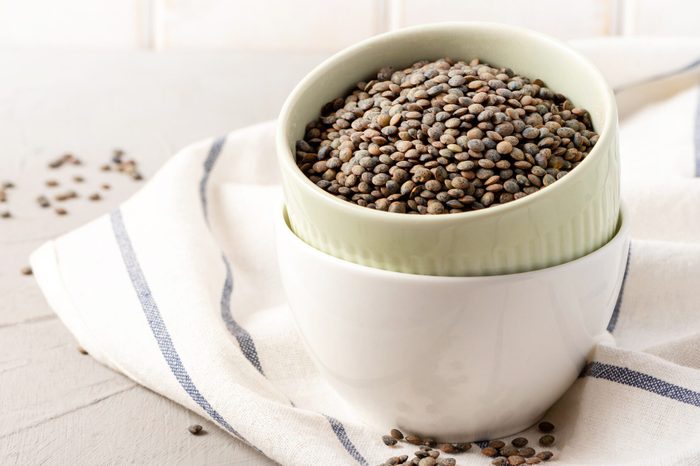
How much iron do you need?
“Adult males and postmenopausal females need 8 mg [of iron] daily,” Zhang says. Women in their reproductive years need 18 mg per day–and the World Health Organization recommends women boost iron intake during their period, especially if you experience heavy bleeding. To keep up with the heavy demands of childbearing, pregnant women need a whopping 27 mg of iron daily.
Still, too much iron can be a bad thing because the mineral is stored in our bodies, Zhang says. But she adds that it’s generally not much of a concern to ingest high-iron foods in large quantities. “Our bodies tightly regulate the absorption of iron from the digestive tract,” she explains. “However, [getting] too much iron from supplements, especially over a long time, can lead to iron toxicity.”
Iron toxicity is a dangerous medical emergency that can lead to liver damage and even death. According to the StatPearls research, iron toxicity only occurs with excess intake of iron supplements—not food. The exception to this general rule is a condition called hemochromatosis, a genetic disorder that causes your body to accumulate too much iron.
For daily wellness updates, subscribe to The Healthy by Reader’s Digest newsletter and follow The Healthy on Facebook and Instagram. Keep reading:





















